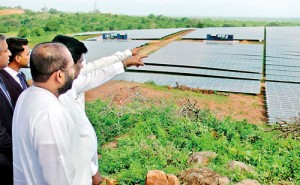Solar power to be harnessed for power generation

The Minister and other invitees at the solar power plant
HAMBANTOTA – Sri Lanka is to switch over to alternate energy sources such as solar and wind power by 2050 in lieu of thermal energy to reduce the carbon footprint of the country. “However some professionals like engineers are bemused and skeptical whether solar and wind power can fulfil the total energy requirements of the country,” said the Deputy Minister of Power and Renewable Energy Ajith Perera following the commissioning of the first utility scale solar power plant at Baruthankanda, Hambantota last week.
He said the government’s intention however is to contribute to the reduction of global warming for sustenance of the future of mankind. The plant was commissioned by the Minister of Power and Renewable Energy Ranjith Siyambalapitiya at a ceremony attended by government and private sector officials. The LOLC Group and Sagasolar Power (Pvt) Ltd built the solar plant at a cost of Rs. 2.6 billion to generate 10 MW of power for the country’s main power grid. The project is a collaboration between LOLC Group and Faber Capitol Ltd as key equity providers and was financed by DFCC Bank, Commercial Bank and the HNB.
Mr. Perera said that President Maithripala Sirisena who represented Sri Lanka at the recent Paris Climate Conference was a signatory to the accord to reduce noxious gas emissions in the country that contribute to global warming. He said the future aim of the government was to purchase power from the private sector solely based on a competitive price formula. “Research done by many scientists have found that solar power was the least expensive source of energy required for a country and our aim is to protect environmental degradation of the country. The government will provide facilities and other incentives to the private sector to develop alternate energy sources such as solar and wind power,” he said.
The massive plant was built on 45 acres on a desolate area which was declared as an Energy Development Area by a gazette notification 1720/ 5 on 23rd of August 2011 under Sri Lanka Sustainable Energy Authority Act. The solar project is said to be over seven times larger than other existing solar projects in the country and will supply 20 GWh to provide annual electricity needs of 15,000 typical homes in the country. The hallmark of the project is it reduces carbon dioxide emission from power generation associated with the national electricity generation by a margin of 11,000 tonnes per year. The Ministry of Power and Energy with the Ceylon Electricity Board launched its first 1.2 MW Pilot solar power project around seven years ago with assistance from Japan and Korea and declared 600 acres of land at Hambantota as an ‘energy development’ area by a gazette notification.
Minister Siyambalapitiya said Sri Lanka has received the lowest rainfall during a 10-year period that had adversely affected the cultivation of crops and have reduced hydropower generation of electricity, causing a drinking water problem in rural areas.”I am happy that two private companies at this juncture have ventured into power generation to supply the national grid. We also invite private companies to find new innovations to contribute to the development of the country. We have received many proposals to make use of unutilized land in rural areas to build new highways and waterways to breed fish.”
Deputy Chairman, LOLC Group Ishara Nanayakkara stated that renewable energy has gained prominence in the Sri Lankan economy and the LOLC Group is poised to play a key role in enhancing commitment to environmental stewardship.”We are highly excited to venture into solar power generation of this magnitude by the private sector.”
Managing Director of Faber Capitol Dilshan Hettiarachchi said that they were honoured to be involved in the development of Sri Lanka’s first utility scale solar project. He said generation of energy from solar power is the next frontier in Sri Lanka’s energy generation journey.


